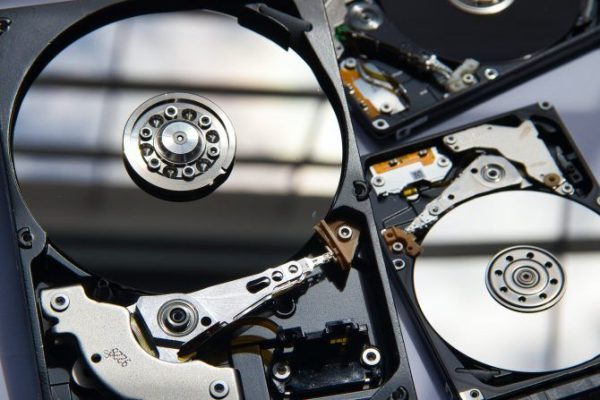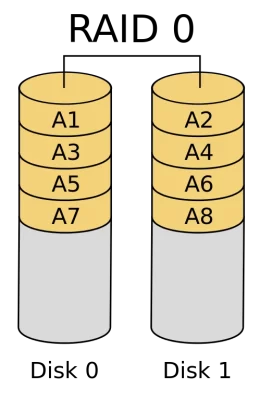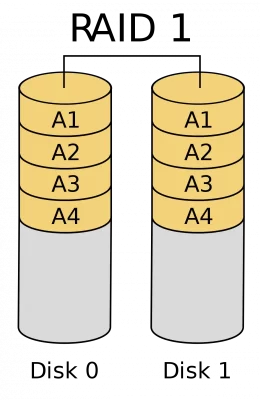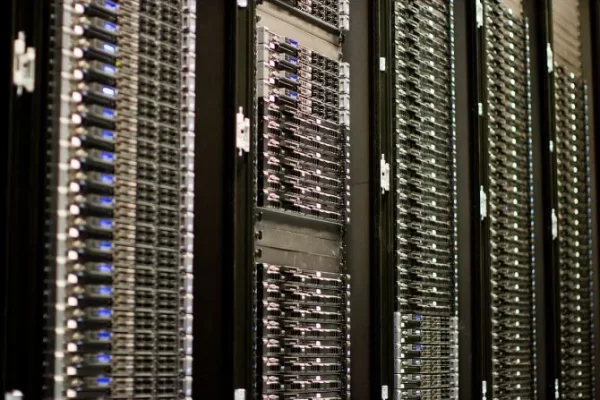Managing multiple hard drives can be a challenging task, but RAID technology makes it easier. With six defined levels of RAID and hybrid options available to combine various disks into one single unit, you have plenty of ways to store your data securely. In this article, we will compare two base-level configurations: the popularly used RAIN 0 setup versus an efficient alternative -RAID 1. We also provide several other comparisons among different technologies for those interested in further exploring their capabilities and use cases!
- RAID 1 vs RAID 5
- RAID 5 vs RAID 6
- RAID 5 vs RAID 10
- Hardware RAID vs Software RAID

What Is RAID 0: Speed Over Safety
RAID 0 is an innovative technology that enables incredibly rapid data access and transfer speeds. Striping divides up large files into smaller sections which are then spread across multiple disks for lightning-fast reading, allowing users to take advantage of faster processing without any interruption from backups.

Example
By optimally distributing your 100GB file across two disks, you can cut loading times in half! Each disk would get five 10GB portions that are numbered sequentially; odd-numbered for Disk 1 and even-numbered for Disk 2. Adding more disks to the array will only compound this efficiency – however many discs are used, load times could be reduced by up to a fraction of their original time!
Advantages of RAID 0
- Enjoy lightning-fast read/write speeds without compromising storage capacity.
- With no parity check system, every bit of your drive’s space can be used for data storage!
- RAID 0 is the most convenient RAID option, being compatible with any sort of controller.
- Setting it up has never been easier!
- Purchasing this item is a great way to get the most bang for your buck!
Disadvantages of RAID 0
- RAID 0 might boast greater data speeds, but that comes at the price of lacking any fault-tolerance capabilities – meaning if you accidentally misplace or modify your info, there’s no way to bring it back. As a result, RAID 0 isn’t suitable for those who handle highly critical information and need extra protection against loss!
- RAID 0 setups may seem like a popular choice for data storage, but they come with potentially disastrous consequences. If one drive fails in the set up all stored information is lost and no backups are available to rescue it – making this configuration an incredibly risky option compared to other forms of setup.
What Is RAID 1: A Race in Redundancy
RAID 1 technology ensures that crucial data is always secure and backed up. By mirroring one drive onto another, the exact same information can be accessed in two locations – allowing users to rest assured their important files are both safe and available in case of an emergency.

Example
A unique storage system is available that can keep your data safe and secure with incredible speed. By writing the same 100GB file onto multiple drives, any changes made to one will be instantly mirrored elsewhere – meaning no pesky wait times when it comes to making new updates! Data loading also benefits from this process; by reading files simultaneously via numerous drives you get an incredibly rapid response time – perfect for gaming or performing advanced tasks. Mirroring across extra devices provides additional assurance against the loss of valuable information too, so why not give it a try today?
Advantages of RAID 1
- RAID 1 offers a unique form of data security by mirroring information across two or more hard drives, ensuring that even if one disk fails, your valuable data remains safe and sound.
- RAID 1 provides the ultimate data security; if one disk fails, you won’t even know it! The system will instantly switch to a backup drive with no interruption for the user. Talk about peace of mind!
- RAID 1 ensures that your data is always available and ready to use when you need it. With two or more disks storing the same information, there’s no risk of losing anything – plus, since multiple drives can be read at once, this type of storage delivers an incredibly efficient performance.
Disadvantages of RAID 1
RAID 1 provides a secure advantage when it comes to data storage, allowing files and information to be automatically duplicated on multiple drives. This means that even if one drive fails, the same amount of capacity is still available – giving you peace of mind while sacrificing half your total storage space in return.
RAID 0 vs RAID 1 Critical Distinction
- RAID 0 and RAID 1 can both provide reliable storage options, but with some key differences.
- Stripping is used in the cheaper option of RAID 0 to create higher performance rates than those achievable using data mirroring in a more expensive RAID 1 setup.
- RAID 0 storage is superior to RAID 1, offering peak performance that can’t be matched by its counterpart. With RAID 0’s advantages come at a cost: if one drive fails, all data will be lost whereas with RAID 1 you have the peace of mind of knowing your files are safe in case disaster strikes!
- RAID 0 offers lightning-fast read and write speeds; RAID 1, while more moderate, is still a solid option.
- RAID 0 offers the speed of no-wait writing, while RAID 1 sacrifices some write performance for added security.
- RAID 0 data organization is a breeze compared to the complexity of RAID 1. Though more complicated, this type of configuration offers improved security and reliability for your valuable files!
Use Cases: When to Use RAID 0 in Real-Life Scenarios
RAID 0 is a popular storage solution, often seen in personal computers but only recommended for environments where data isn’t particularly sensitive. With its low cost and efficient performance, it may be just the configuration your PC needs!
Gaming and Gaming Servers
By implementing RAID 0, gamers can enjoy a better gaming experience with decreased loading times. Meanwhile, servers are able to offer much quicker speeds for vibrant online games that store data in the cloud.

Live Streaming Audio/Video
If you’re looking to get the most out of your live streaming performance, RAID 0 can be a great solution for avoiding stuttered video and pesky technical issues. With no reliance on data redundancy, this configuration provides a powerful option for optimizing stream quality.
Capturing Uncompressed HD Video
When capturing high-definition footage, you need a hard disk that can rapidly store vast amounts of information without compromising the quality or crisp detail. Otherwise, accessing your recorded video files could feel like an eternity!
Image and Video Editing
Working with detailed graphics and visuals can be a challenge, especially when high-speed performance is essential. Without the necessary speed to support large files, design professionals face major obstacles in creating their digital masterpieces.
Use Cases: When to Use RAID 1 in Real-Life Scenarios
RAID 1 is a popular choice for companies looking to safeguard their most important data – ensuring the highest levels of security and minimal risk of loss. A wise investment, RAID 1 provides peace of mind that valuable information will remain secure at all times.
Electronic Records or Archives
RAID 1 technology allows databases with high user traffic to remain reliable and stable, providing users with a seamless experience every time.

Financial Systems
Accurately tracking finances is critical for business success; if vital data related to accounting and payroll disappear, the consequences could be devastating.
Enterprise Web Servers
The backbone of an enterprise lies in its essential tools, and any data loss can be a critical blow to business operations. Ensuring these vital components are secure is paramount for continued success.
Frequently Asked RAID Questions
Is RAID 0 faster than a single disk?
RAID 0 is the speed demon of storage systems. Instead of relying on a single drive to read data, it utilizes multiple disks simultaneously – allowing for maximum performance and lightning-fast retrieval times!
Can RAID 1 be used as a data backup?
RAID 1 is not dependable for safeguarding data – a proper backup strategy should always be utilized to protect critical information.
How safe is it to use a RAID 1 setup?
RAID 1 provides a great level of peace of mind with its built-in redundancy, preventing data loss due to drive failure. Even if one hard drive crashes unexpectedly, you can still access your data thanks to the multiple copies backed up across two or more drives!
Can you use different drive sizes in RAID 0?
When making a RAID 0 setup, it’s best to use an array of disks that are all the same size – because otherwise, you’ll have added storage capacity equivalent to only twice the smallest disk which could leave lots left unused.
Why choose a RAID 0 setup over an SSD?
With a RAID 0 setup, you can get lightning-fast speeds for less than the cost of an SSD per gigabyte– maximizing performance without breaking your budget!
Should you choose RAID 0 or RAID 1?
When it comes to reliable data protection, RAID 0 and RAID 1 are two popular choices. Those needing a performance advantage may opt for the former while those seeking extra assurance look towards the latter – whether you have precious memories or critical business information stored on your hard drive, there’s an option that can meet your specific needs!
